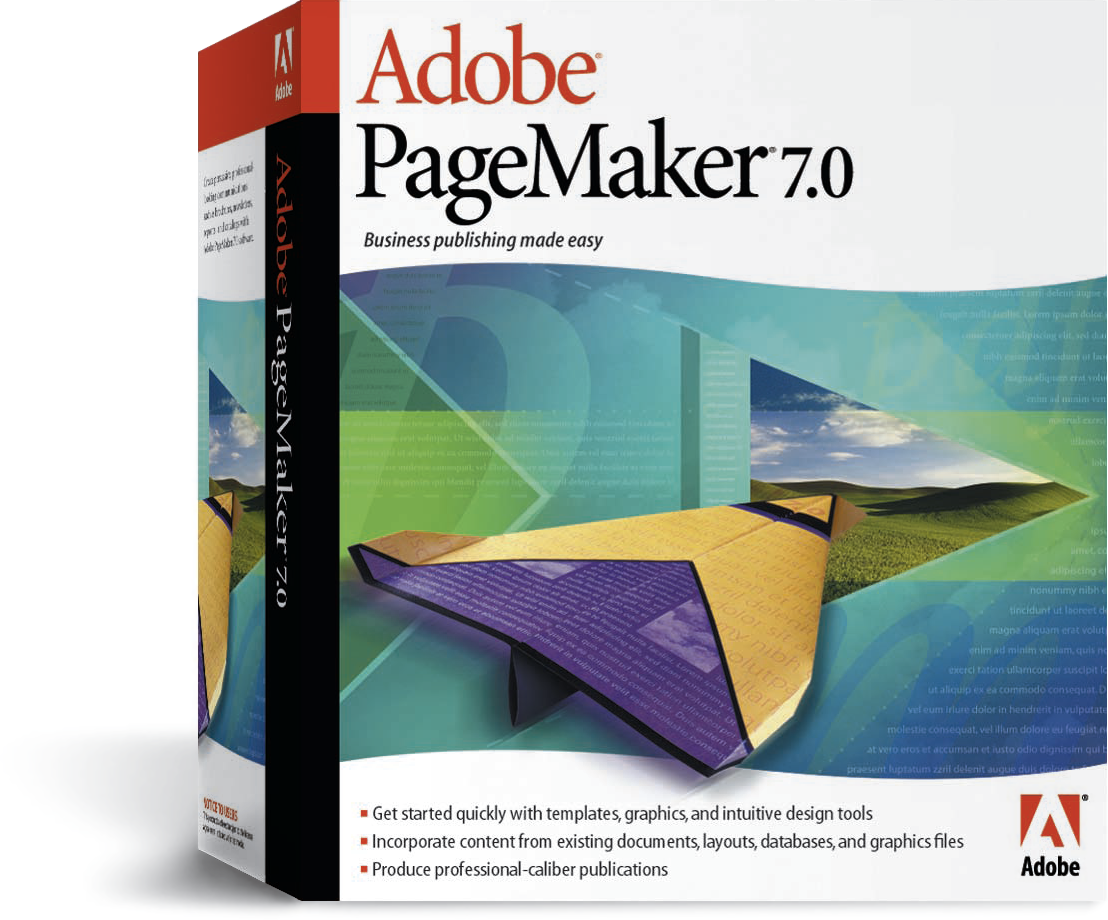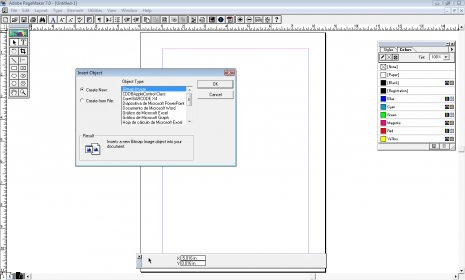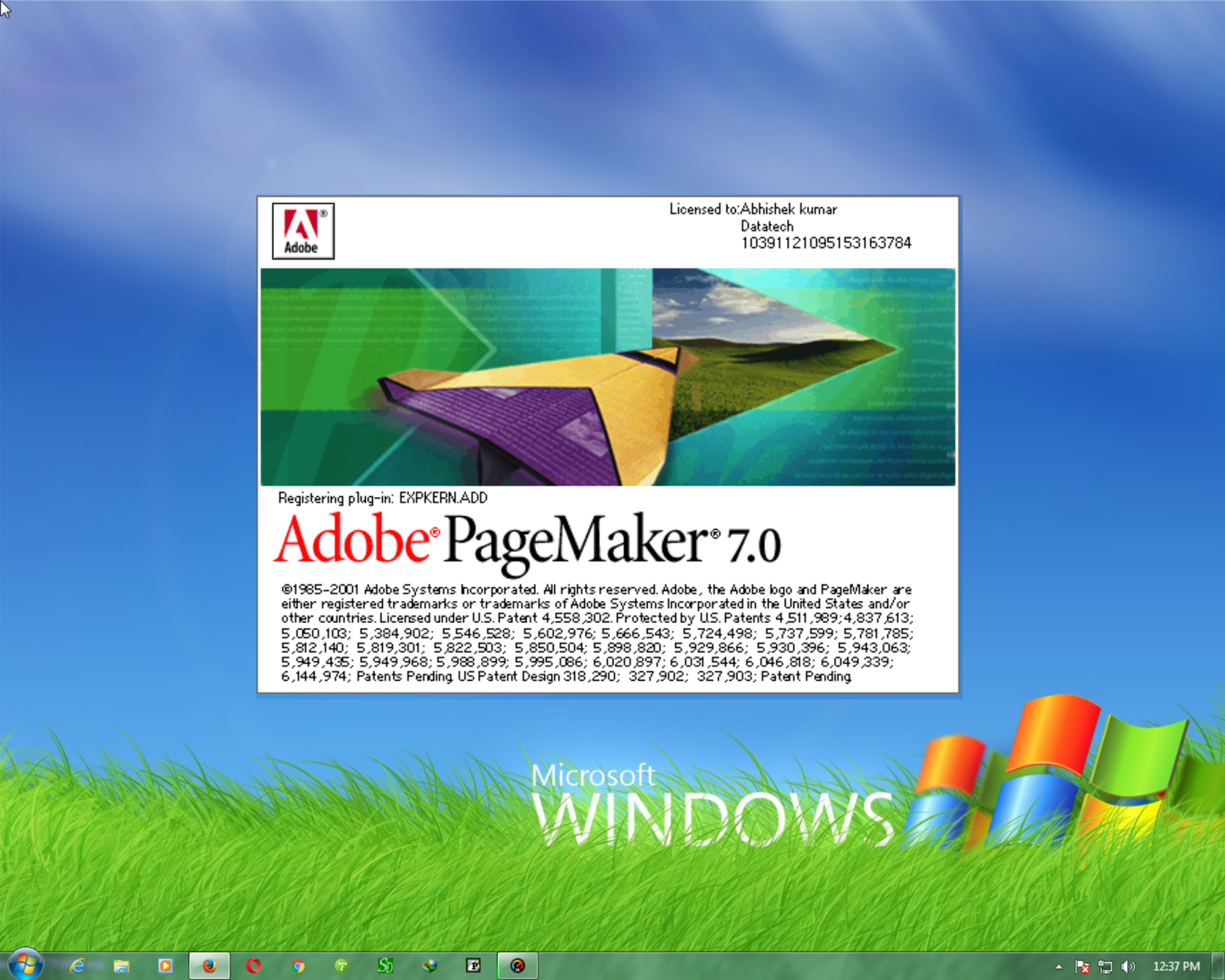Pagemaker
Adobe PageMaker 7 software is the ideal page layout program for business, education, and small- and home-office professionals who want to create high-quality publications such as brochures. A platform for brand content administrators. Absolute Control. You define the layouts and content you want made available to your customers, and turn them loose. PageMaker resources Forums. Share your PageMaker questions, suggestions, and information with other Adobe product users and expert guest hosts through the Adobe User to User Forums. Sign up for Proxy. Adobe's new quarterly online magazine covers software tips, troubleshooting advice, design trends, and much much more. Download Adobe Pagemaker for Windows now from Softonic: 100% safe and virus free. More than 27063 downloads this month. Download Adobe Pagemaker lates.
| Original author(s) | Aldus Corporation |
|---|---|
| Developer(s) | Adobe Systems |
| Final release | 7.0.2 / 30 March 2004 |
| Operating system | Windows XP and earlier Mac OS 9 OS/2 v3.01 |
| Type | Desktop publishing |
| License | Trialware |
| Website | www.adobe.com/products/pagemaker/ |
Adobe PageMaker (formerly Aldus PageMaker) is a discontinued desktop publishing computer program introduced in 1985 by the Aldus Corporation on the Apple Macintosh.[1] The combination of the Macintosh's graphical user interface, PageMaker publishing software, and the Apple LaserWriterlaser printer marked the beginning of the desktop publishing revolution. Ported to PCs running Windows 1.0 in 1987,[2] PageMaker helped to popularize both the Macintosh platform and the Windows environment.[3][4]
A key component that led to PageMaker's success was its native support for Adobe Systems' PostScript page description language. After Adobe purchased the majority of Aldus's assets (including FreeHand, PressWise, PageMaker, etc.) in 1994 and subsequently phased out the Aldus name, version 6 was released. The program remained a major force in the high-end DTP market through the early 1990s, but new features were slow in coming. By the mid-1990s, it faced increasing competition from QuarkXPress on the Mac, and to a lesser degree, Ventura on the PC, and by the end of the decade it was no longer a major force. Quark proposed buying the product and cancelling it, but instead, in 1999 Adobe released their 'Quark Killer', Adobe InDesign. The last major release of PageMaker came in 2001, and customers were offered InDesign licenses at a lower cost.
Release history[edit]
- Aldus Pagemaker 1.0 was released in July 1985 for the Macintosh and in December 1986 for the IBM PC.[5][6]
- Aldus Pagemaker 1.2 for Macintosh was released in 1986 and added support for PostScript fonts built into LaserWriter Plus or downloaded to the memory of other output devices.[7] PageMaker was awarded a Codie award for Best New Use of a Computer in 1986. In October 1986, a version of Pagemaker was made available for Hewlett-Packard's HP Vectra computers. In 1987, Pagemaker was available on Digital Equipment's VAXstation computers.[6]
- Aldus Pagemaker 2.0 was released in 1987. Until May 1987, the initial Windows release was bundled with a full version of Windows 1.0.3; after that date, a 'Windows-runtime' without task-switching capabilities was included.[8][9] Thus, users who did not have Windows could run the application from MS-DOS.
- Aldus Pagemaker 3.0 for Macintosh was shipped in April 1988.[10] PageMaker 3.0 for the PC was shipped in May 1988[11] and required Windows 2.0,[12] which was bundled as a run-time version.[13] Version 3.01 was available for OS/2 and took extensive advantage of multithreading for improved user responsiveness.
- Aldus PageMaker 4.0 for Macintosh was released in 1990 and offered new word-processing capabilities, expanded typographic controls, and enhanced features for handling long documents.[14] A version for the PC was available by 1991.
- Aldus PageMaker 5.0 was released in January 1993.[6]
- Adobe PageMaker 6.0 was released in 1995, a year after Adobe Systems acquired Aldus Corporation.
- Adobe PageMaker 6.5 was released in 1996. Support for versions 4.0, 5.0, 6.0, and 6.5 is no longer offered through the official Adobe support system. Due to Aldus' use of closed, proprietary data formats, this poses substantial problems for users who have works authored in these legacy versions.
- Adobe PageMaker 7.0 was the final version made available. It was released 9 July 2001, though updates have been released for the two supported platforms since. The Macintosh version runs only in Mac OS 9 or earlier; there is no native support for Mac OS X,[15] and it does not run on Intel-based Macs without SheepShaver. It does not run well under Classic, and Adobe recommends that customers use an older Macintosh capable of booting into Mac OS 9. The Windows version supports Windows XP, but according to Adobe, 'PageMaker 7.x does not install or run on Windows Vista.'[16]

End of development[edit]

Development of PageMaker had flagged in the later years at Aldus and, by 1998, PageMaker had lost almost the entire professional market[17] to the comparatively feature-richQuarkXPress 3.3, released in 1992, and 4.0, released in 1996. Quark stated its intention to buy out Adobe and to divest the combined company of PageMaker to avoid anti-trust issues. Adobe rebuffed the offer and instead continued to work on a new page layout application code-named 'Shuksan' (later 'K2'), originally started by Aldus, openly planned and positioned as a 'Quark killer'. This was released as Adobe InDesign 1.0 in 1999.[18][19]
The last major release of PageMaker was 7.0 in 2001, after which the product was seen as 'languishing on life support'.[20] Adobe ceased all development of PageMaker in 2004 and 'strongly encouraged' users to migrate to InDesign, initially through special 'InDesign PageMaker Edition' and 'PageMaker Plug-in' versions, which added PageMaker's data merge, bullet, and numbering features to InDesign, and provided PageMaker-oriented help topics, complimentary Myriad Pro fonts, and templates.[21] From 2005, these features were bundled into InDesign CS2, which was offered at half-price to existing PageMaker customers.[22][23]
No new major versions of Adobe PageMaker have been released since, and it does not ship alongside Adobe InDesign.
Reception[edit]
BYTE in 1989 listed PageMaker 3.0 as among the 'Distinction' winners of the BYTE Awards, stating that it 'is the program that showed many of us how to use the Macintosh to its full potential'.[24]
References[edit]
- ^Adams, Peter (16 March 2004). 'PageMaker Past, Present, and Future'. Archived from the original on 9 July 2007. Retrieved 27 June 2007.
- ^'Aldus Now Shipping Pagemaker for IBM PC'. InfoWorld. 9 (6). 1987.
- ^Edwards, Benj (3 May 2013). 'Born Apple: Six famous Windows apps that debuted on the Mac'. Macworld.
- ^Pfiffner, Pamela (11 September 2007). 'Opinion: Adobe's world'. Macworld.
- ^'A potted history of computers - the eighties'. www.hodgy.net.
- ^ abc'History of Aldus Corporation – FundingUniverse'. www.fundinguniverse.com.
- ^Keith Thompson: Pagemaker remains Chief Composer. In: InfoWorld Volume 8, Issue 23, 9 June 1986. ISSN0199-6649. Pages 39–40.
- ^Ken Freeze: Flexibility for PC Pros is Page Layout Strength. In: InfoWorld Volume 9, No. 12, 23 March 1987. ISSN0199-6649. Pages 42-44. - Review of PageMaker for the PC. Remarks about the Windows-bundle on p. 43, first column.
- ^Michael J. Miller: First Look. In: InfoWorld Volume 9, Issue 9, 2 March 1987. ISSN0199-6649. - Short comparison of PageMaker, Ventura Publisher and Harvard Professional Publisher, a modified version of Superpage by Bestinfo.
- ^Aldus Corp. Ships PageMaker 3.0 for the Macintosh. BusinessWire, 24 March 1988.
- ^Aldus Ships PC Version of PageMaker 3.0. Businesswire, 19 May 1988.
- ^The precise Windows version required was 2.03, which is the exact version number of the first publicly available Windows 2 release. cf. Windows Version History. Microsoft Knowledge Base, Document No. 32905. Last access date 22 July 2010.
- ^Stuart J. Johnston: Pagemaker 3.0 Adds Support for Style Sheets. In: InfoWorld, Volume 10, Issue 22, 30 May 1988, page 20.
- ^'Business - Aldus Releases Pagemaker Version - Seattle Times Newspaper'. community.seattletimes.nwsource.com.
- ^'PageMaker 7 System requirements'. Adobe. Archived from the original on 3 July 2007. Retrieved 27 June 2007.
- ^'How Adobe Products Support Windows Vista'(PDF). Adobe. 12 February 2007. Retrieved 27 June 2009.
- ^Matthew Honan (1 June 2001). 'Is 7 PageMaker's Lucky Number?'. Macworld.
- ^Ann Marsh (31 May 1999). 'Pride goeth before destruction'. Forbes. Retrieved 5 February 2013.
- ^Gretchen Peck (September 2004). 'QuarkXPress versus Adobe InDesign'. Digital Output. Archived from the original on 6 March 2014.
- ^Galen Gruman (17 May 2004). 'Adobe PageMaker Plug-in Pack'. Macworld.
- ^Jim Dalrymple (5 January 2004). 'Adobe discontinues PageMaker dev, offers plug-ins for InDesign'. Macworld.
- ^'FAQ for Adobe PageMaker Users'(PDF). Adobe. 2005. Retrieved 6 March 2014.
- ^'InDesign CS2 Frequently Asked Questions'(PDF). Adobe. Retrieved 27 June 2007.
- ^'The BYTE Awards'. BYTE. January 1989. p. 327.

External links[edit]

- ^https://www.referenceforbusiness.com/history2/54/Aldus-Corporation.htmlReference for Business Company History Index Information Technology Aldus Corporation - Company Profile, Information, Business Description, History, Background Information on Aldus Corporation41 First Avenue SouthSeattle, Washington 98104-2871U.S.A.
The US company Aldus Corporation was founded in February 1984 in Seattle, Washington, by Paul Brainerd (b. 1947). Brainerd has a graduate degree in journalism at the University of Minnesota and worked at the Minneapolis newspaper Star and Tribune. In 1980 he joined Atex in Redmond, Washington, a company that sold computer-assisted publishing equipment to the newspaper industry. In 1983, the plant was closed, thus Brainerd and five other Atex engineers decided to stay in the Pacific Northwest and start up their own company.
Brainerd and his partners decided to name their company Aldus, after Aldus Pius Manutius (Teobaldo Mannucci) (1449–1515), a famous fifteenth-century Venetian pioneer in publishing, known for standardizing the rules of punctuation and also presenting several typefaces, including the first italic. Manutius went on to found the first modern publishing house, the Aldine Press.
The flagship program of Aldus Co—PageMaker was released in July 1985. This groundbreaking program was the first ever desktop publishing application and revolutionized the use of personal computers, virtually creating the desktop publishing industry. The term desktop publishing was itself coined by Brainerd.

PageMaker relied on a graphical user interface, and was initially for the then new Apple Macintosh, in 1987 for PCs running the then new Windows 1.0. PageMaker relies on Adobe Systems’ PostScript page description language. Suddenly anyone could design brochures. Publishers had to become computer literate, and Apple started selling Macs and LaserWriters in large numbers. Aldus helped Apple to market its hardware to customers who wanted desktop publishing capabilities. In return, Apple featured Aldus’s software in much of its advertising, and also helped the fledgling company distribute its program.
PageMaker 1.0 screen
Retailed for $495 PageMaker 1.0 (see the upper screenshot) included all the basic elements needed to lay out pages: free form drag and drop positioning of page elements, sophisticated type tools, a well-chosen selection of drawing tools, the ability to import text and graphics (most importantly, EPS files) from other applications, and the ability to print to high resolution PostScript printers with WYSIWYG accuracy. The users could easily create professional-quality books, newspapers, newsletters, brochures, pamphlets, and other graphic products.
PageMaker not only made desktop publishing possible, it spawned entire cottage industries for clip art, fonts, service bureau output and scanning, and specialty products for laser printing such as foil overlays.
Aldus succeeded to make the PageMaker program accessible to all kinds of computers and operating systems, signing agreements with Hewlett-Packard, Microsoft Corporation, IBM, Wang Laboratories and Digital Equipment. Then it decided to offer its program to computer users outside the United States, establishing itself as Europe’s leading producer of desktop publishing software by the spring of 1988. Controlling nearly half of the British, French, and German markets for these products, PageMaker was the world’s fourth most popular software program.
Despite the popularity of the PageMaker, Aldus’s status as a single-product company caused some concern among management and investors. The company needed to move beyond PageMaker to other products and functions in order to continue its rapid growth and remain profitable. Thus in 1987 Aldus introduced FreeHand, a raster graphics drawing program, and SnapShot, an instant electronic photography software package for use on personal computers. Later Aldus presented SuperPaint, Personal Press, Digital Darkroom, PhotoStyler, PressWise and PageAhead.
Pagemaker Tutorial
In January 1988, sales of the PageMaker program topped 200000, with 90000 copies of the program shipped in the preceding year. That spring, Aldus introduced updated versions of PageMaker for use on the Macintosh and on IBM-compatible PCs. With this advance, Aldus maintained its dominant grip on the desktop publishing market.
Pagemaker For Mac
PageMaker continued to evolve, reaching new heights with its 1992 version 4.2, which had such essential features as text rotation and a story editor. Despite some interesting marketing ploys however Aldus had lost significant market share to the rival QuarkXPress, which had some powerful features, such as color separation, which PageMaker then lacked. Later QuarkXPress continued to gain market share, due largely to ignorance and mythology regarding PageMaker’s capabilities. Most people who used both programs preferred PageMaker, but that didn’t seem to help Aldus, and their dwindling revenues eventually led to their acquisition in 1995 by Adobe, which re-introduced PageMaker as Adobe PageMaker and subsequently updated it to version 6, 6.5, and finally 7 in 2001. Then, Adobe rebranded the next version of PageMaker to Adobe InDesign. InDesign was developed in Seattle by the PageMaker product team.